Topics
Category
Era
Farmers' Holiday Association in Minnesota
Grant County farmers among the marchers to the State Capitol, 1935. Photographer: George E. Luxton. Minnesota farm families practiced active citizenship and made demands on the government to honor their labor and protect their farms.
Founded in 1932, the short-lived Farmers' Holiday Association (FHA) is remembered for successfully fighting against farm foreclosures. The FHA also unsuccessfully lobbied Congress for a federal system that would pay farmers for their crops based on the cost of production.
American farmers had been facing economic problems since the end of World War I. After the war, demand for farm goods went down, but the supply stayed the same. Prices fell, and many poorer farmers began losing their farms. When the stock market crashed in 1929, the economy worsened and farm prices fell even more. Middle-class farmers who had stayed afloat during the 1920s began losing their farms to foreclosure in the 1930s.
The Farmers' Holiday Association was both an official organization and an organic, spontaneous social movement. The FHA's goal was to unite farmers in a buying and selling "holiday." A farm holiday, or strike, meant farmers would refuse to buy goods, sell commodities, or pay taxes until they received a fair rate for their labor. They called this fair rate the cost of production.
The FHA also wanted farmers to have better access to credit. Credit was important because most farmers had to borrow money to pay for each year's seed, plus equipment maintenance and animal care costs. When banks failed and credit tightened, they were unable to buy the things they needed to earn a living and pay back their debt.
As an official organization, the National Farmers' Holiday Association was founded on May 3, 1932 by Iowan Milo Reno. Reno was a former president of the Iowa Farmers Union. The Farmers Union advocated for farmers' issues such as financial aid, tariff reform, and buying/selling cooperatives. Reno had also been involved with earlier movements such as the Farmers Alliance, the Nonpartisan League, and the Populist Party. Reno thought farmers needed to try more extreme tactics to raise the price of crops and livestock. He suggested a strike, where farmers would coordinate and keep their products off the market. With a lower supply, he knew that prices would rise. The Farmers Union agreed that it was a good plan, but they did not want to lead the strike themselves. As a result, Reno created the Farmers' Holiday Association. John H. Bosch, Reno's friend and president of the Kandiyohi Farmers Union, founded a Minnesota branch on July 29, 1932.
Iowa farmers began striking on August 8, 1932. It was a spontaneous strike, not organized by movement leaders, and it was met with violence by self-styled deputies. The August strike was over by the end of the month, but it attracted national attention in an election year. President Herbert Hoover and presidential candidate Franklin D. Roosevelt both addressed it. In late September, Minnesota farmers struck as well.
With the national attention gained from the first strike, farmers involved with the holiday movement felt bold. In early 1933, they started to intervene in foreclosures. First they tried mediation. They would send three to seven farmers to talk to the debtors and creditors and try to come to an agreement to avoid foreclosure. If talk failed, they tried intimidation.
The FHA is best remembered for the forceful ways that they stopped foreclosures. Sometimes they blocked the roads and physically prevented a sheriff from selling a farmers' home and land. Other times they held penny auctions. At a penny auction, everyone refused to bid more than a few pennies for the farm. The farm would then be given back to its original owner with no debt, and the bank would be only a few cents richer.
During the winter and spring of 1933, penny auctions took place all over the upper Midwest. By March, seven states had started to restrain farm foreclosures with legislation or executive action. That month, 20,000 Minnesota farmers marched on the state capitol in St. Paul to support FHA-friendly legislation.
In the fall of 1933, FHA attempts at a nation-wide strike failed when dairy farmers disagreed with corn farmers over tactics and their united front was broken. With that high-profile failure, the FHA lost its political power. It continued to exist, however, until 1937, when it was officially folded back into the Farmers Union.
Bibliography
Choate, Jean. "'We Want Our Money Back': The National Farmers' Process Tax Recovery Association in Minnesota and Iowa." Minnesota History 53, no.3 (Fall 1990): 100–111. http://collections.mnhs.org/MNHistoryMagazine/articles/52/v52i03p100-111.pdf
Nass, David, ed. Holiday: Minnesotans Remember the Farmers' Holiday Association. Marshall, MN: Plains Press, Southwest State University, 1984.
Nielson, Kim E. "Who Were These Farmer Radicals? The Douglas County Farm Holiday Association." Minnesota History 51, no.7 (Fall 1989): 270–280. http://collections.mnhs.org/MNHistoryMagazine/articles/51/v51i07p270-280.pdf
Shover, John L. "The Farmers' Holiday Association Strike, August 1932." Agricultural History 39, no.4 (October 1965): 196–203.
Related Resources
Primary
"Farm Holiday Statements are Published." The Sheboygan Press, May 22, 1933.
Editor's note: This can be found in the 1933 papers of Governor Olson, Peterson, and Benson (see below).
North Dakota Farm Holiday Association. The 1936 Holiday Association's Hand book and Manual of Useful Information. Bismarck, ND: The Farm Holiday Association, 1936.
HD9007
Pamphlets relating to agriculture and the produce trade in Minnesota, 1920–
Pamphlet Collection, Minnesota Historical Society, St. Paul
Description: This folder of pamphlets includes the report of the Minnesota Farmers' Holiday Association annual convention held on October 9-10, 1934.
Records of governors Floyd B. Olson, Hjalmar Petersen, and Elmer A. Benson, 1932–1938
State Archives, Minnesota Historical Society, St. Paul
http://www2.mnhs.org/library/findaids/gr00063.xml
Description: Correspondence with Governors Olson, Petersen, and Benson, organized by year then alphabetical by subject. Materials on the Farmers' Holiday Association can be found under topics like "farm holiday," "farm strike," and "farm relief."
Secondary
Dyson, Lowell K. "Radical Farm Organizations and Periodicals in America, 1920-1960." Agricultural History 45, no.2 (April 1971): 111–120.
Luoma, Everett E. The Farmer Takes a Holiday: The Story of the National Farmers' Holiday Association and the Farmers' Strike of 1932–1933.New York: Exposition Press, 1967.
Nass, David L. "Recollections of Rural Revolt: An Interview from the Oral History Collection of the Southwest Minnesota Historical Center." Minnesota History 44, no.8 (Winter 1975): 304–308. http://collections.mnhs.org/MNHistoryMagazine/articles/44/v44i08p304-308.pdf
Nathanson, Iric, "In 1933, a Governor Moved Boldly to Halt Foreclosures." MinnPost, June 4, 2008.
http://www.minnpost.com/politics-policy/2008/06/1933-governor-moved-boldly-halt-foreclosures
Shover, John L. "Letters from American Farmers." Agricultural History 36, no.3 (July 1962): 163–168.
———. Cornbelt Rebellion: The Farmers' Holiday Association. Urbana: University of Illinois Press, 1965.
Stock, Catherine McNicol. Main Street in Crisis: The Great Depression and the Old Middle Class on the Northern Plains. Chapel Hill: University of North Carolina Press, 1992.
Web
Encyclopedia of the Great Plains. Farmers Holiday Association.
http://plainshumanities.unl.edu/encyclopedia/doc/egp.pd.020
"Minnesota Farmers Sign Order for Strike." The Cornell Daily Sun, May 13, 1933.
http://cdsun.library.cornell.edu/cgi-bin/cornell?a=d&d=CDS19330513.2.48
Related Images
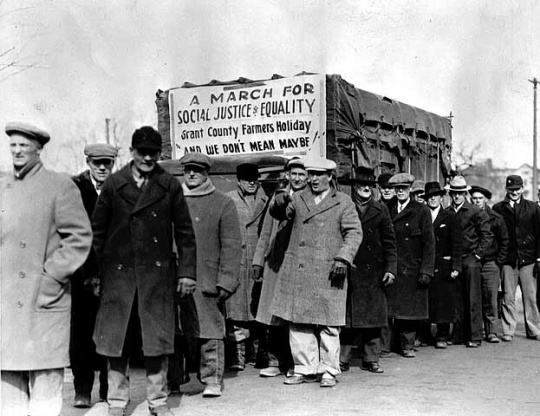
Grant County farmers among the marchers to the State Capitol.
Grant County farmers among the marchers to the State Capitol, 1935. Photographer: George E. Luxton. Minnesota farm families practiced active citizenship and made demands on the government to honor their labor and protect their farms.
More Information
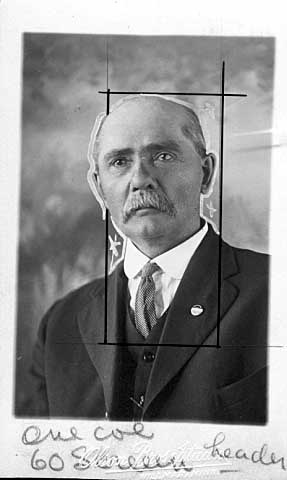
John B. Bosch
John B. Bosch, leader of the Farmers' Holiday Association in Minnesota, c.1915.
Public domain
Holding Location
More Information
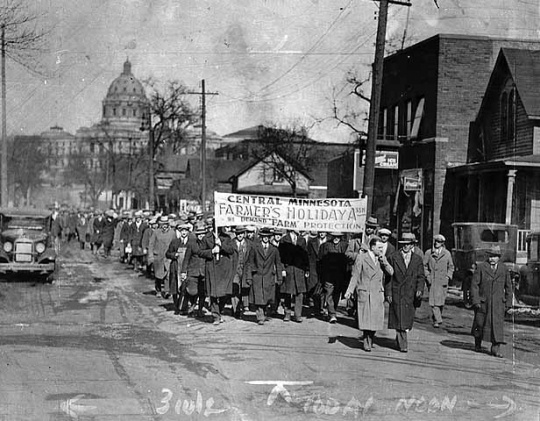
Farmers Holiday Association marching from Capitol to demand relief.
Farmers Holiday Association marching from Capitol to demand relief, March 22, 1933. Photograph by the St. Paul Daily News.
Holding Location
More Information
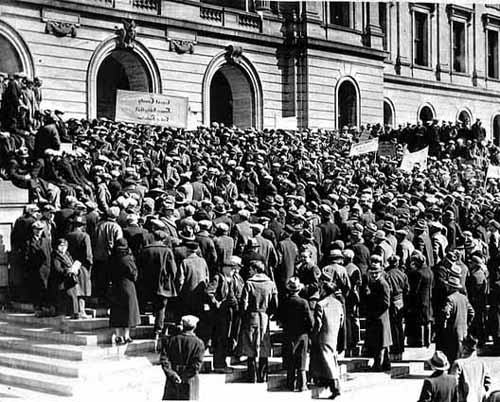
Farmers storm Capitol to demand relief
Farmers storm Capitol to demand relief, March 22, 1933. Photograph by the St. Paul Daily News.
Holding Location
More Information
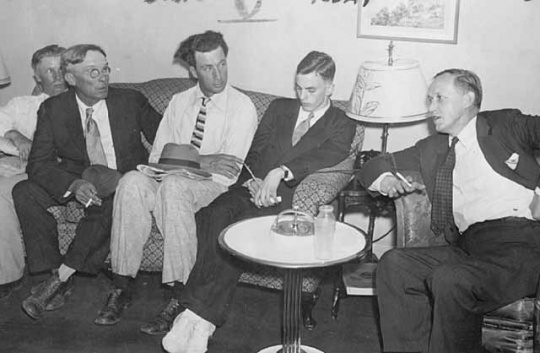
Administration head Harry L. Hopkins to discuss drought relief
Farmers Holiday Association representatives meet with Works Progress Administration head Harry L. Hopkins to discuss drought relief, 1936. Photograph by the St. Paul Daily News.
Holding Location
More Information
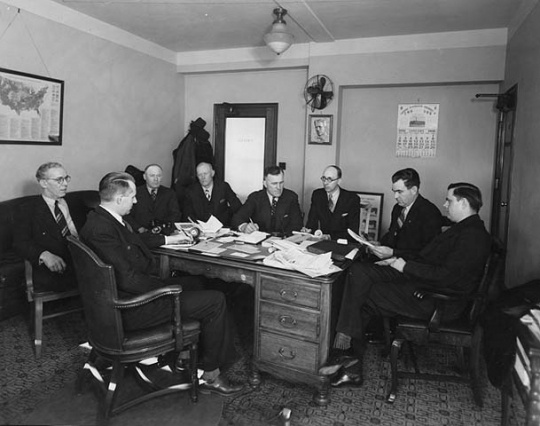
Farmers Holiday Association conference, State Office Building, St. Paul
Farmers Holiday Association conference, State Office Building, St. Paul. January 1938. Photograph by Brown & Fenny.
Holding Location
More Information
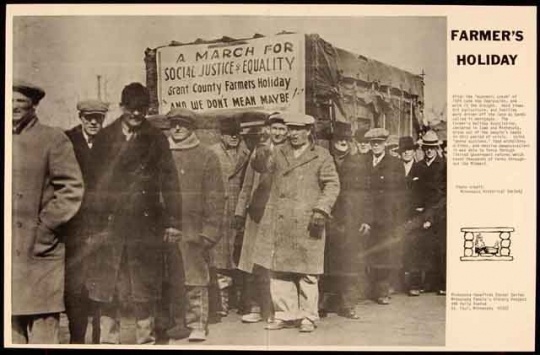
Farmer's Holiday
Farmer's Holiday Association poster featuring a photograph of Grant County farmers marching to the State Capitol, c.1935.
Holding Location
More Information
Related Articles
Turning Point
In September 1932, Minnesota farmers associated with the newly formed Farmers' Holiday Association go on strike, following the lead of Iowa farmers who struck in August. The Iowa and Minnesota strikes, which are a surprise to FHA leadership, are successful in garnering national attention for the plight of Midwestern farmers.
Chronology
May 3, 1932
July 29, 1932
August, 1932
September 1932
Early 1933
Fall 1933
1936
1937
Bibliography
Choate, Jean. "'We Want Our Money Back': The National Farmers' Process Tax Recovery Association in Minnesota and Iowa." Minnesota History 53, no.3 (Fall 1990): 100–111. http://collections.mnhs.org/MNHistoryMagazine/articles/52/v52i03p100-111.pdf
Nass, David, ed. Holiday: Minnesotans Remember the Farmers' Holiday Association. Marshall, MN: Plains Press, Southwest State University, 1984.
Nielson, Kim E. "Who Were These Farmer Radicals? The Douglas County Farm Holiday Association." Minnesota History 51, no.7 (Fall 1989): 270–280. http://collections.mnhs.org/MNHistoryMagazine/articles/51/v51i07p270-280.pdf
Shover, John L. "The Farmers' Holiday Association Strike, August 1932." Agricultural History 39, no.4 (October 1965): 196–203.
Related Resources
Primary
"Farm Holiday Statements are Published." The Sheboygan Press, May 22, 1933.
Editor's note: This can be found in the 1933 papers of Governor Olson, Peterson, and Benson (see below).
North Dakota Farm Holiday Association. The 1936 Holiday Association's Hand book and Manual of Useful Information. Bismarck, ND: The Farm Holiday Association, 1936.
HD9007
Pamphlets relating to agriculture and the produce trade in Minnesota, 1920–
Pamphlet Collection, Minnesota Historical Society, St. Paul
Description: This folder of pamphlets includes the report of the Minnesota Farmers' Holiday Association annual convention held on October 9-10, 1934.
Records of governors Floyd B. Olson, Hjalmar Petersen, and Elmer A. Benson, 1932–1938
State Archives, Minnesota Historical Society, St. Paul
http://www2.mnhs.org/library/findaids/gr00063.xml
Description: Correspondence with Governors Olson, Petersen, and Benson, organized by year then alphabetical by subject. Materials on the Farmers' Holiday Association can be found under topics like "farm holiday," "farm strike," and "farm relief."
Secondary
Dyson, Lowell K. "Radical Farm Organizations and Periodicals in America, 1920-1960." Agricultural History 45, no.2 (April 1971): 111–120.
Luoma, Everett E. The Farmer Takes a Holiday: The Story of the National Farmers' Holiday Association and the Farmers' Strike of 1932–1933.New York: Exposition Press, 1967.
Nass, David L. "Recollections of Rural Revolt: An Interview from the Oral History Collection of the Southwest Minnesota Historical Center." Minnesota History 44, no.8 (Winter 1975): 304–308. http://collections.mnhs.org/MNHistoryMagazine/articles/44/v44i08p304-308.pdf
Nathanson, Iric, "In 1933, a Governor Moved Boldly to Halt Foreclosures." MinnPost, June 4, 2008.
http://www.minnpost.com/politics-policy/2008/06/1933-governor-moved-boldly-halt-foreclosures
Shover, John L. "Letters from American Farmers." Agricultural History 36, no.3 (July 1962): 163–168.
———. Cornbelt Rebellion: The Farmers' Holiday Association. Urbana: University of Illinois Press, 1965.
Stock, Catherine McNicol. Main Street in Crisis: The Great Depression and the Old Middle Class on the Northern Plains. Chapel Hill: University of North Carolina Press, 1992.
Web
Encyclopedia of the Great Plains. Farmers Holiday Association.
http://plainshumanities.unl.edu/encyclopedia/doc/egp.pd.020
"Minnesota Farmers Sign Order for Strike." The Cornell Daily Sun, May 13, 1933.
http://cdsun.library.cornell.edu/cgi-bin/cornell?a=d&d=CDS19330513.2.48








